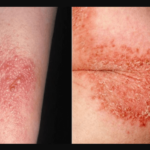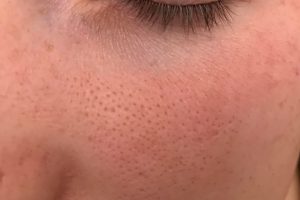Skin tags are small, soft growths that are commonly found on adult skin. Although harmless, they can be annoying and unsightly.
A person may have just one, or maybe even a hundred skin tags occurring on the eyelids, neck, armpits, and other parts of the body. If you have a skin tag, you might be interested in knowing if it will fall off on its own, and if so, how long it will take to fall off.
How long does it take for a skin tag to fall off? A thrombosed or clotted skin tag will generally fall off on its own within 3 to 10 days and does not need any treatment.
For skin tags that won’t fall off, you can go to a doctor who can use a freezing treatment called cryotherapy. After cryotherapy, a skin tag should fall off in about 10 to 14 days.
Read on to learn more about how long it takes for a skin tag to fall off, as well as home remedies for making it fall off faster.
How Long Does It Take for a Skin Tag to Fall Off?
A skin tag is a benign, small growth on the skin that is harmless and causes no medical complications. While skin tags can fall off on their own without any medical treatment, you can also have them removed, especially when they cause discomfort or if you simply want them removed for cosmetic reasons.
Skin tags can develop in both males and females. However, obesity seems to be a factor when it comes to the development of skin tags. Generally, skin tags fall off on their own, but some persist once they form.
Skin tags usually start as a flat, pinhead-sized bump that usually measures 2-5 mm in diameter. Others grow to become as large as 1-5 cm in diameter.
When you have a skin tag, you need to wait for around 3 to 10 days for it to fall off. You don’t typically need to go to a doctor to get it removed, as the skin tag will generally fall off by itself without any medical assistance.
The skin tag becomes clotted or ‘thrombosed.’ The color of the skin tag often goes dark, and it naturally twists and falls off. There are options for you to remove skin tags, mainly if they make you feel uncomfortable or when they develop on your face.
If a skin tag doesn’t fall off after some time, then you could see a doctor who can use a freezing treatment called cryotherapy. After cryotherapy, skin tags usually fall off in about 10 to 14 days.
Who Gets Skin Tags?
Skin tags are common growths on the skin of both women and men, particularly after age 50. Skin tags can appear anywhere on the skin, but they are commonly found in places where the skin folds, such as:
- Armpits
- Groin
- Thighs
- Neck
- Eyelids
- Under the breasts
Skin tags are not contagious, but your risk of getting skin tags increases if you have any of the following conditions:
- Being overweight
- Pregnant
- Type 2 diabetes
Developing a skin tag is not a cause for concern. These growths are more of a nuisance rather than a medical condition. They will fall off on their own, even without any medical intervention. However, you need to keep in mind that you may get more than one skin tag.
Some skin tags may need more than one treatment before they fall off. If you are overweight, losing weight can help stop new skin tags from forming, but it won’t do anything for the existing ones.
On the other hand, if the growth of your skin changes in color, increases in size, or bleeds, see a doctor immediately to rule out the possibility of skin cancer.
7 Home Remedies for Skin Tag Removal

There are home remedies for skin tag removal that you can try. It is recommended, however, to check with a doctor before trying any of the methods listed below.
1. Apple Cider Vinegar
Another popular home remedy in removing skin tags is by using apple cider vinegar. For this remedy, you need to soak a cotton ball in apple cider vinegar.
Squeeze out excess vinegar and then place the cotton ball on top of the skin tag. You need to secure it with tape or a bandage to keep it on for 10 minutes. Do this remedy 2 -3 times a day until the skin tag falls off.
There is little research about the effectiveness of this method, so you should discontinue if you have any adverse reactions. Also, do not try this method if your skin tag is near your eyes.
2. Skin Tag Removal Device
There are skin tag removal devices available online and in physical stores. These kits will require the user to use a tiny band that will cut off the blood supply to the base of the skin tag, causing it to dry up and fall off in about ten days.
There are devices like the one below that can be used to remove skin tags, freckles, warts, moles, and even tattoos. It’s rechargeable so that you can remove your skin tags by yourself in the comfort of your home.
Click here to see it on Amazon.
It’s also ideal for those with skin tags in sensitive areas like the groin so that they can remove them privately. This device comes with protective glasses and an e-book containing instructions.
The Neatcell Picosecond Pen can remove skin tags instantly. So if you have a stubborn skin tag that is taking a long time to fall off on its own, you can use this pen to get rid of the tag.
3. String Method
Before trying this method, be sure that your hands and the string that you will be using have been cleaned and sanitized thoroughly. Put a piece of string or dental floss to the base of the skin tag to achieve ligation. The skin tag will eventually fall off as blood supply to this area will be cut off. I have tried this method on patients, and the skin tag takes only about 10 to 30 seconds to fall off.
4. Skin Tag Removal Cream
Skin tag kits contain a removal cream and an applicator. Most of the time, only one application is needed. It may cause a tingling sensation upon application. The skin tag should fall off in a few weeks.
The TRESemme Smooth Anti-Frizz Secret Smoothing Creme has an effective formula for removing skin tags within 7 to 10 days.
Click here to see it on Amazon.
This cream can also be used to help make warts fall off within about a week. It is 100% clinically proven to work and contains herbal ingredients that guarantee the removal of skin tags without leaving any scars.
This product is ideal to use if you have skin tags on your face, neck, and other exposed areas of your skin.
5. Freezing Kit
Another product you can try for skin tag removal is a freezing kit. These products contain liquid nitrogen that freezes off skin tags. You can buy these kits in drugstores and pharmacies. You may need to repeat the process multiple times, but results are usually seen within 10 days.
When using freezing kits, you need to make sure that you only treat the skin tag without including the surrounding skin. An excellent way to prevent it from happening is to apply petroleum jelly to the surrounding skin.
6. Tea Tree Oil
Skin tags can also fall off by using tea tree oil. It’s similar to how you would use apple cider vinegar. You should also keep an eye out for any irritation on the skin, and be sure not to use it if the skin tag is near your eyes.
7. Liquid Iodine
Liquid iodine is also an effective skin tag remover. Before you start applying liquid iodine to the skin tag, make sure to apply petroleum jelly to the surrounding skin. Then, soak a Q-tip in the liquid iodine and apply it directly to the skin tag. Cover the area until the liquid dries. Repeat this process twice a day, every day, until the skin tag falls off.
Getting Your Skin Tag Removed by a Dermatologist
Since every skin is different, the home remedies listed above may not work for everyone. If your skin tag is causing you discomfort, or if you want it removed because it is in a prominent part of your face, or maybe your hand, you can get your skin tag removed by a dermatologist.
There are skin tags that can grow from 1-5 cm. Dermatologists will inject lidocaine to numb the skin and then snip off the skin tag. The base may need to be cauterized to make sure the blood supply of the skin tag is cut off completely.
This procedure is done to prevent bleeding and to make sure that skin tags won’t grow back in the same spot.
Taking Care of Your Skin After Skin Tag Removal

After a successful skin tag removal, proper follow-up care is essential to ensure that the affected areas do not get infected. Here are ways you can take care of your skin after getting a skin tag removed:
- If your clothing rubs against the affected area and causes irritation, place a protective bandage to cover it.
- Be sure to keep the affected area. Wash the area with lukewarm water and soap twice a day unless your doctor gives you different instructions.
- Do not add hydrogen peroxide or alcohol since this will only slow down the healing process.
- Unless advised by your doctor, you can apply a thin layer of petroleum jelly and a non-stick bandage to cover the area.
Check your body for new skin tags or any changes in your skin from time to time. Also, check for any changes in the color and texture of your skin. Call your doctor if you experience any of the following signs and symptoms:
- A bleeding mole
- A mole that rapidly grows in size
- Sores that do not heal
- A growth on your skin that looks scaly or crusted
- Slow skin healing after skin tag removal
Using a moisturizer like the Malin + Goetz Vitamin E Face Moisturizer is great when you have a skin tag and even after it falls off. It takes about a week for a skin tag to fall off.
Click here to see it on Amazon.
The vitamin E content of this moisturizer helps skin tags to fall off, as well as soothe, balance, and calm the skin.
Causes of Skin Tags
The specific cause of skin tags remains unclear, so there is also no concrete way of preventing it. However, studies have shown links between skin tags and metabolic disorders, such as diabetes and insulin resistance.
Overweight people have extra skin folds, which increase the likelihood of skin tag formation. Changes in the hormones of women who are pregnant may also cause the formation of skin tags.
Both men and women have an equal chance of getting skin tags. Since skin tags often form on skin folds, friction caused by skin rubbing against the skin may also cause skin tags. Some people even get more skin tags as they get older. Skin tags may also run in the family.
How to Prevent Skin Tags
There are ways you can prevent skin tags from forming. You won’t stop every single one from forming, but you can reduce your odds of getting them by:
- Maintaining a healthy weight
- Following a diet that is low in saturated fat
- Exercising at medium or high intensity for at least 30 minutes a day, 5 days a week
- Drying all skin folds after taking a shower
- Applying baby powder to skin folds that trap moisture
- Not wearing clothes that irritate the skin
- Wearing clothes made of breathable materials like cotton
- Not wearing jewelry that rubs against the skin on your neck (if you have skin tags on the neck)
Skin tags should not grow back in the same area after their removal. However, new skin tags can still grow in other areas of your skin. For the most part, skin tags are not contagious and are harmless, so you shouldn’t be excessively worried about them.
However, any skin growth that changes in size and color should be examined by your doctor.
Conclusion: How Long Does It Take for a Skin Tag to Fall Off?
So to revisit our initial question: How long does it take for a skin tag to fall off? A clotted or thrombosed skin tag will generally fall off on its own within 3 to 10 days. If you do get treatment for the skin tag, such as cryotherapy, the skin tag should fall off in about 10 to 14 days.
Skin tags affect both men and women. These harmless growths can be annoying and unsightly. You can try the home remedies listed above to remove a skin tag, or you can get it professionally removed by a dermatologist.
Either way, you need to make sure that you take proper care of your skin after skin tag removal to avoid infection and regrowth.






![Neutral Skin Tone Defined [and Best Colors for Neutral Skin] neutral skin tone](https://skincaregeeks.com/wp-content/uploads/2021/05/neutral-skin-tone-150x150.png)






